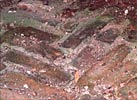![]()
The contents on this page remain on our website for informational purposes only.
Content on this page will not be reviewed or updated.
 |
 |
||||
| Roman Period | |||||
|
Towcester’s origins can be traced back to the arrival of the Romans, when the walled garrison town was initially given the Roman name of ‘Lactodorum’. |
|||||
|
There is considerable evidence to suggest that the Romans had previously constructed a substantial building on the site now occupied by St Lawrence Church. Sir Henry Dryden's excavations in 1883, under and around the south porch, have uncovered tiles from a Roman hypocaust, which provided the building with heating. Box flue tiles, pilae and hollow box voussoir tiles have also been found.
The discovery of a piece of quarter-rounded, blue painted cement moulding which would have been part of a hot or cold plunge bath, is further evidence that this site may have been the bath house of a mansio (major administrative building). |
|||||
|
Areas of Roman herringbone brick flooring (opus spicatum) remain and a section of herringbone flooring can still be seen from the outside boiler house staircase, to the east of the south porch. The bricks (12cm x 8cm x 4cm) are set edgeways in pink Roman cement. The first south wall of the church sits on this flooring. |
|
||||
